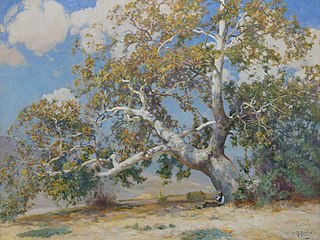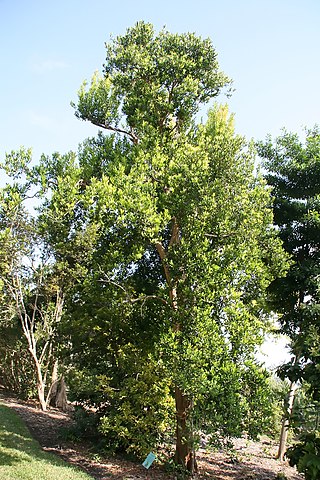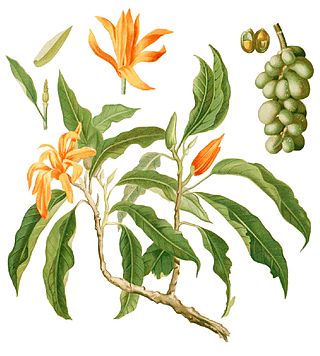
Platanus racemosa is a species of plane tree known by several common names, including California sycamore, western sycamore, California plane tree, and in North American Spanish aliso. Platanus racemosa is native to California and Baja California, where it grows in riparian areas, canyons, floodplains, at springs and seeps, and along streams and rivers in several types of habitats. It can be found as far north as Tehama and Humboldt counties.

Jacaranda mimosifolia is a sub-tropical tree native to south-central South America that has been widely planted elsewhere because of its attractive and long-lasting violet-colored flowers. It is also known as the jacaranda, blue jacaranda, black poui, Nupur or fern tree. Older sources call it J. acutifolia, but it is nowadays more usually classified as J. mimosifolia. In scientific usage, the name "jacaranda" refers to the genus Jacaranda, which has many other members, but in horticultural and everyday usage, it nearly always means the blue jacaranda.

Nyctanthes arbor-tristis is a species of Nyctanthes native to South Asia and Southeast Asia. It is commonly known as night-blooming jasmine, tree of sadness, tree of sorrow, coral jasmine and in Singapore seri gading. Despite its common name, the species is not a "true jasmine" and not of the genus Jasminum.

Griselinia is a genus of seven species of shrubs and trees, with a highly disjunct distribution native to New Zealand and South America. It is a classic example of the Antarctic flora. It is the sole genus in the family Griseliniaceae. In the past it was often placed in Cornaceae but differs from that in many features.

Pimenta racemosa is a species of plant in the myrtle family (Myrtaceae) that is native to the Caribbean region. Common names include West Indian bay tree, bay rum tree, and ciliment.

Ulmus thomasii, the rock elm or cork elm, is a deciduous tree native primarily to the Midwestern United States. The tree ranges from southern Ontario and Quebec, south to Tennessee, west to northeastern Kansas, and north to Minnesota.

Ficus racemosa, the cluster fig, red river fig or gular, is a species of plant in the family Moraceae. It is native to Australia and tropical Asia. It is a fast-growing plant with large, very rough leaves, usually attaining the size of a large shrub, although older specimens can grow quite large and gnarled. It is unusual in that its figs grow on or close to the tree trunk, termed cauliflory.

Magnolia champaca, known in English as champak, is a large evergreen tree in the family Magnoliaceae. It was previously classified as Michelia champaca. It is known for its fragrant flowers, and its timber used in woodworking.

Polyscias racemosa, or false 'ohe, is a species of flowering plant in the family Araliaceae. As Munroidendron racemosum, the species was until recently considered to be the only species in the monotypic genus Munroidendron. With the change in classification, Munroidendron is now obsolete. Polyscias racemosa is endemic to the Hawaiian island of Kauai. It is very rare in the wild and some of its original habitat has been replaced by sugar cane plantations. It was thought for some time to be probably extinct, but was rediscovered a few years prior to 1967.

Hymenosporum is a monotypic genus in the family Pittosporaceae. The sole included species is Hymenosporum flavum, commonly known as native frangipani, which is a rainforest tree native to New Guinea, Queensland and New South Wales. Despite its common name, it is not closely related to the frangipani, but is related to the widespread genus Pittosporum.

Heritiera littoralis, commonly known as the looking-glass mangrove or tulip mangrove, is a mangrove tree in the family Malvaceae native to coastal areas of eastern Africa, Asia, Melanesia and northern Australia. The common name refers to the silvery appearance of the underside of the leaves, resembling a mirror to some degree. The strong timber has uses in marine applications and elsewhere.

Leptospermum laevigatum, commonly known as the coast tea tree, is a species of shrub or small tree that is endemic to south-eastern Australia, but has been widely introduced in other places where it is often considered to be a weed. It has thin, rough bark on the older stems, narrow egg-shaped leaves, relatively large white flowers and flat topped fruit that is shed shortly after reaching maturity.

Sambucus racemosa is a species of elderberry known by the common names red elderberry and red-berried elder.

Barringtonia racemosa is a tree in the family Lecythidaceae. It is found in coastal swamp forests and on the edges of estuaries in the Indian Ocean, starting at the east coast of Mozambique and KwaZulu-Natal to Madagascar, India, Sri Lanka, Malaysia, Maldives, Thailand, Laos, southern China, northern Australia, coastal Taiwan, the Ryukyu Islands and many Polynesian islands.

Schleichera is a monotypic genus of plants in the soapberry family, Sapindaceae. There is only one species, Schleichera oleosa, a tree that occurs in the Indian Subcontinent and Southeast Asia.

Sambucus sieboldiana, commonly called the Japanese red elder, is a deciduous shrub in the moschatel family (Adoxaceae). It is native to East Asia, where it is found in Japan and Korea. Its natural habitat is in thickets and forest edges, in low elevations. It is a common species throughout its range.

Lumnitzera racemosa, commonly known as the white-flowered black mangrove, is a species of mangrove in the family Combretaceae. It is found on the eastern coast of Africa and other places in the western Indo-Pacific region. It has one accepted variety from the noniminate species, Lumnitzera racemosa var. lutea (Gaudich.) Exell.

Sunder Nursery, formerly called Azim Bagh or Bagh-e-Azeem, is a 16th-century heritage park complex adjacent to the Humayun's Tomb, a UNESCO World Heritage Site in Delhi. Originally known as Azim Bagh and built by the Mughals in the 16th century, it lies on the Mughal-era Grand Trunk Road, and is spread over 90 acres. Future plans aim to link nearby areas to develop it into India's largest park covering 900 acres.

Rhizophora racemosa is a species of mangrove tree in the family Rhizophoraceae. It has a patchy distribution on the Pacific coast of Central and South America, occurs in places on the Atlantic coast of that continent, and has a more widespread range on the Atlantic coast of West Africa.

Spatalla racemosa, the lax-stalked spoon, is a flower-bearing shrub that belongs to the genus Spatalla and forms part of the fynbos. The plant is native to the Western Cape of South Africa where it is found in the Kogelberg, Groenland mountains, Babilonstoringberge, Kleinrivier Mountains as well as at Villiersdorp.























